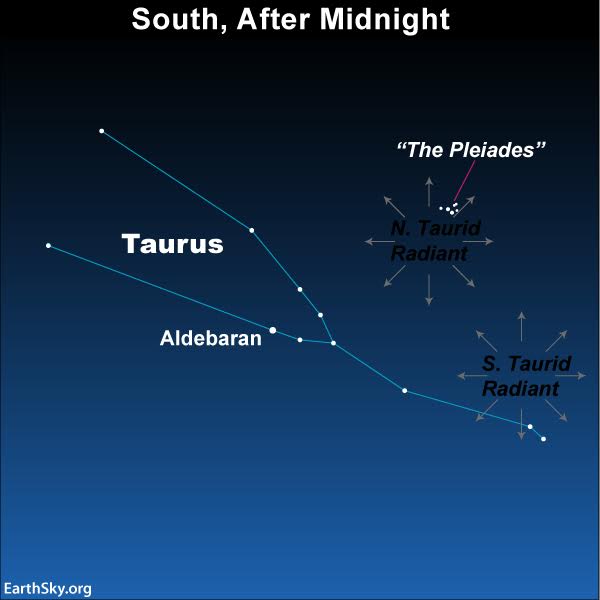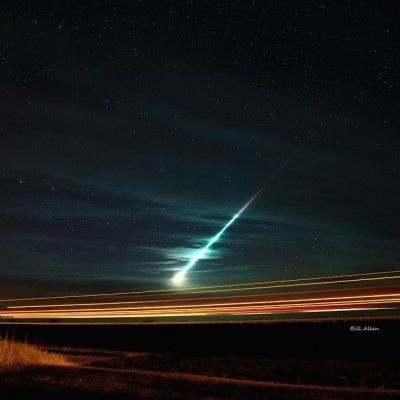
South Taurid meteors
Yes, the 2021 Perseids were grand. But now it’s meteor season, again! There are several good showers between now and the end of the year. And, sometimes, you’ll find conflicting information about the peak dates for meteor showers, especially when it’s a shower with no definite peak. It’s probably safe to assume that the long-lasting South Taurid meteor shower, for example, will ramble along, as it always does, between September 10 and November 20, with no sharp peak. This shower rarely offers more than five meteors per hour. That’s why the moon phase may be more of a factor in watching the South Taurids than any predicted peak date. Read more about how the moon phase will affect the 2021 South Taurids, below.
But the story of the predicted peaks for this shower – which vary from place to place – is interesting.
For the most part, we count on the Observer’s Handbook to provide us with the peak dates for the year’s major meteor showers. The Observer’s Handbook 2021 lists November 5 (6 UTC) as the peak time for the 2021 South Taurid meteor shower.
Yet two other trusted sources give a different date for the South Taurid peak. The International Meteor Organization (IMO) says the night of October 10. The American Meteor Society (AMS) gives the peak night in 2021 as November 2-3.
Why don’t the dates agree?
Astronomer Guy Ottewell, in his 2012 Astronomical Calendar, helps to explain the discrepancy for the peak date of the South Taurid meteor shower. He explained:
Fresh evidence from the International Meteor Organization suggests the southern branch, rather than reaching its maximum in early November as long believed, actually has its peak in October instead.
See what we mean? There are subtleties here.

The moon and the 2021 S. Taurids
This year, the new moon obtrudes on October 6. So in the early part of October 2021, there’s a waxing moon in the sky. Full moonwaning crescent moon rising shortly before sunup, always fun to see. Then new moon will come again on November 4, 2021.
From what we have been able to gather, the Taurid meteor stream consists of an extremely wide roadway of far-flung debris left behind by Comet 2P/Encke. When Earth travels through this belt of comet debris, bits and pieces of Comet 2P/Encke smash into the Earth’s upper atmosphere to vaporize as rather slow-moving Taurid meteors (28 km/17 miles per second).
Yet, the Taurids are known for having a high percentage of fireballs.
Apparently, the original Taurid stream had been perturbed by Jupiter into two branches: South and North Taurids. The South Taurids, the more prominent of the two, are active from about September 10 to November 20, whereas the North Taurids are active from about October 20 to December 10.

Peak dates aside, meteor aficionados will be on the lookout as the South and North Taurids simultaneously produce meteors in late October and early November. Higher rates of Taurid fireballs might happen in seven-year cycles, and the last grand fireball display was in 2015.
In short, the Taurid meteors might produce a “swarm” of fireballs on relatively moonless nights – in early October, and again on the last nights of October and early November – regardless of which date the South Taurid meteor shower peaks!
Bottom line: The South Taurid meteor shower rarely produces more than 5 meteors per hour, but has been known to produce fireballs. The shower is long-running. Watch for it in October and November, 2021
The post Watch for Taurid meteors throughout October first appeared on EarthSky.
0 Commentaires